Key takeaways:
- Feedback is essential in understanding visitor experiences and can transform events by addressing audience needs.
- Mixing methods of feedback collection, such as comment cards, digital surveys, and informal interviews, enhances the richness of insights gained.
- Implementing feedback results in significant changes, such as altering exhibition layouts and creating interactive elements, which fosters deeper audience engagement.
- Measuring the success of changes involves qualitative observations and direct conversations with visitors, revealing emotional impacts beyond numerical data.
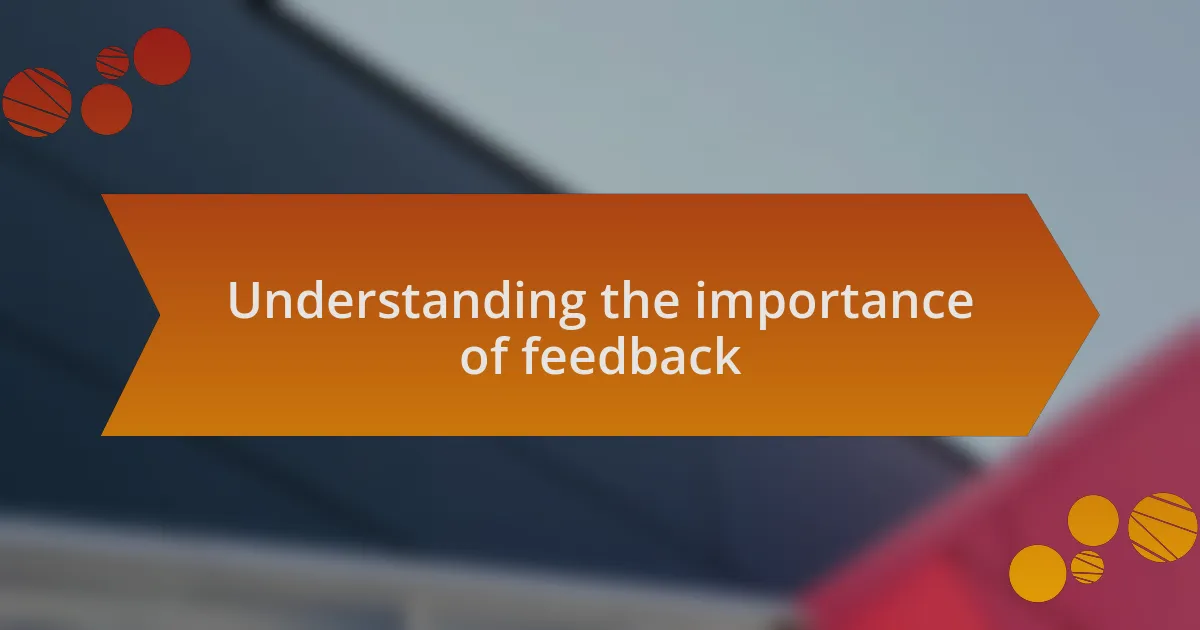
Understanding the importance of feedback
Feedback is a powerful tool that can reshape our understanding of what works and what doesn’t in the context of events at an art gallery. I remember a particular exhibition where the attendance was lower than expected. After gathering feedback, I learned that the marketing hadn’t resonated with potential visitors. It was a wake-up call, and it made me realize how crucial it is to listen to the audience.
When I asked attendees about their experiences, I discovered the value of their perspectives. One visitor mentioned they felt disconnected from the artists because the descriptions lacked personal stories. That simple comment inspired me to weave in narratives that connect the audience to the creators. Isn’t it fascinating how a single piece of feedback can lead to richer, more engaging experiences?
Embracing feedback can feel daunting at times, especially when it reveals flaws in our planning. However, I truly believe that constructive criticism is necessary for growth. It’s like being handed a compass that points us in the right direction. Have you experienced a moment when feedback shifted your perspective? Personally, every time I’ve chosen to embrace those insights, I’ve seen significant transformations in the events I curate.
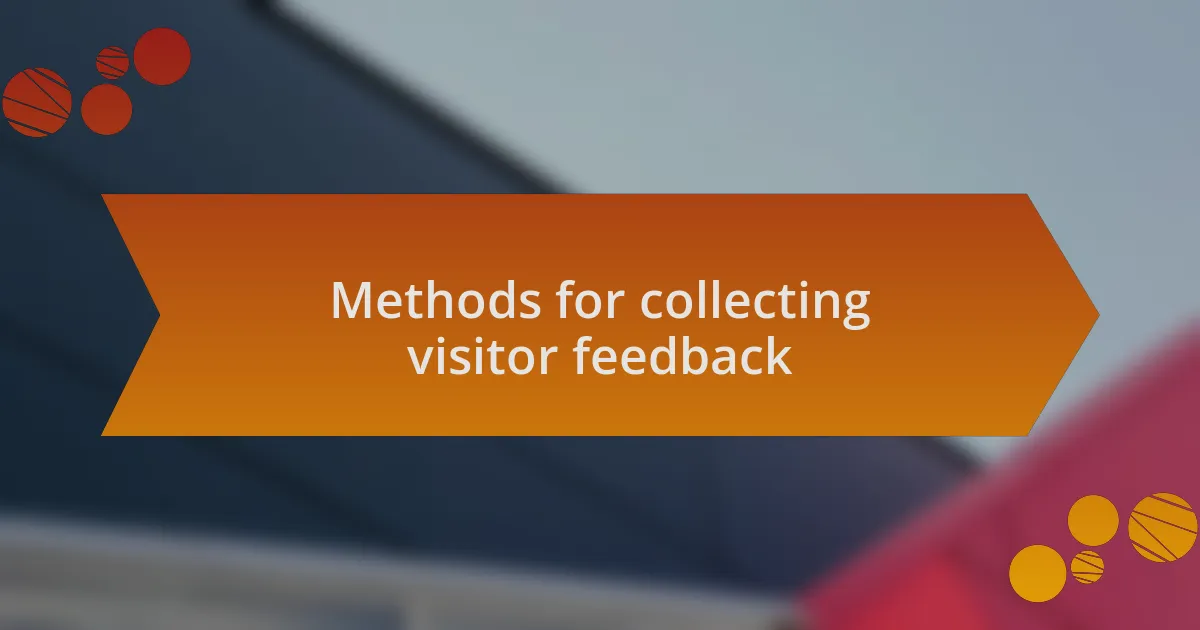
Methods for collecting visitor feedback
To effectively gather visitor feedback, I’ve found that a mix of methods often produces the best results. At one exhibition, I set up a simple feedback station where visitors could fill out comment cards. This approach not only made it easy for them to share their thoughts but also offered a chance for anonymity, which encouraged more honest responses. Have you ever noticed how people are more candid when they can voice their opinions without being identified?
In addition to physical comment cards, I implemented digital surveys after events. I was amazed at how convenient it was for visitors to share their insights via a quick online questionnaire. This method significantly expanded the reach of my feedback collection. When I receive a flurry of responses right after an event, I feel a surge of enthusiasm; it’s like having a treasure trove of ideas ready to help refine our future experiences.
Another method that I swear by is conducting informal interviews. After an event, I often approach a few attendees to chat about their experiences. This one-on-one interaction creates an open dialogue that can lead to revelations I might never get from written surveys. Has there ever been an unexpected detail during a conversation that changed your entire viewpoint? I’ve had visitors share stories that are so profound; they not only enhance the next event but also deepen my connection with the gallery’s audience.
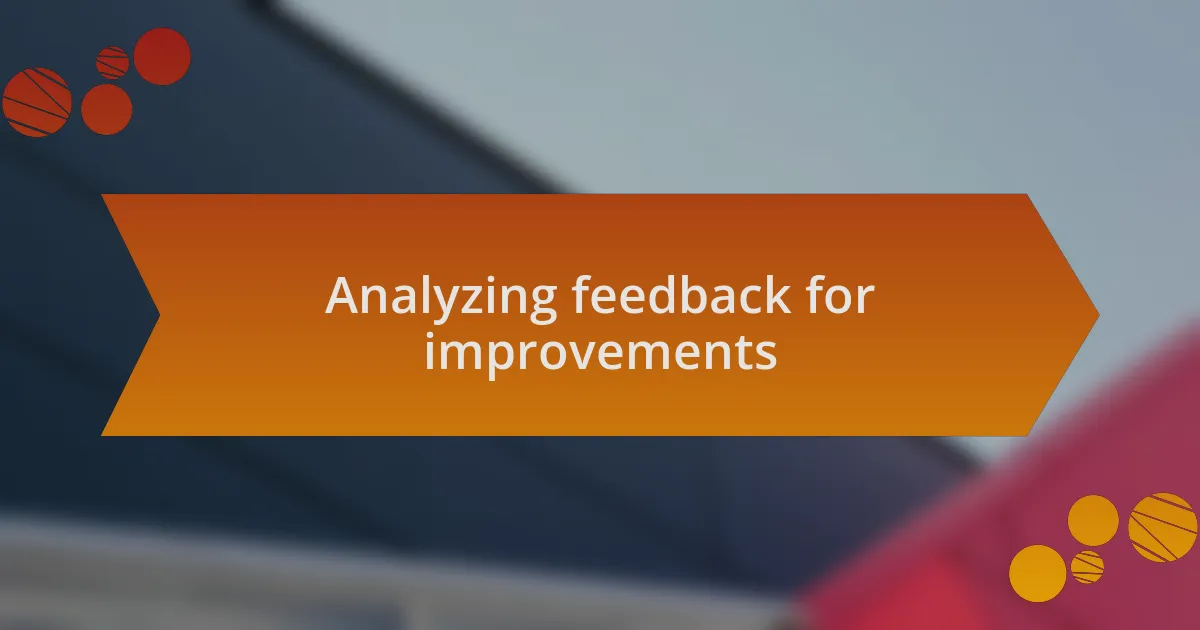
Analyzing feedback for improvements
Analyzing feedback is where the real magic happens. Once I started reviewing the feedback collected, I discovered patterns that were eye-opening. For example, a consistent comment about lighting led me to realize how essential an ambiance is for art appreciation. Isn’t it fascinating how something seemingly minor can transform the overall impact of an event?
I remember one instance when multiple visitors mentioned the need for more interactive elements. This prompted me to envision a hands-on corner at the next exhibition where guests could create their own mini art pieces. The excitement in their voices as they spoke about wanting to engage more deeply was invigorating. Wouldn’t it be amazing to turn their suggestions into reality and watch them flourish?
As I sifted through the feedback, I felt a sense of responsibility to address the critiques earnestly. It’s not just about listening; it’s about translating those insights into tangible changes. Just last month, I implemented a ‘meet the artist’ session based on recommendations, and the thrill in the room was palpable. It’s moments like these that remind me how valuable our visitors’ experiences are in shaping the journey of the gallery.
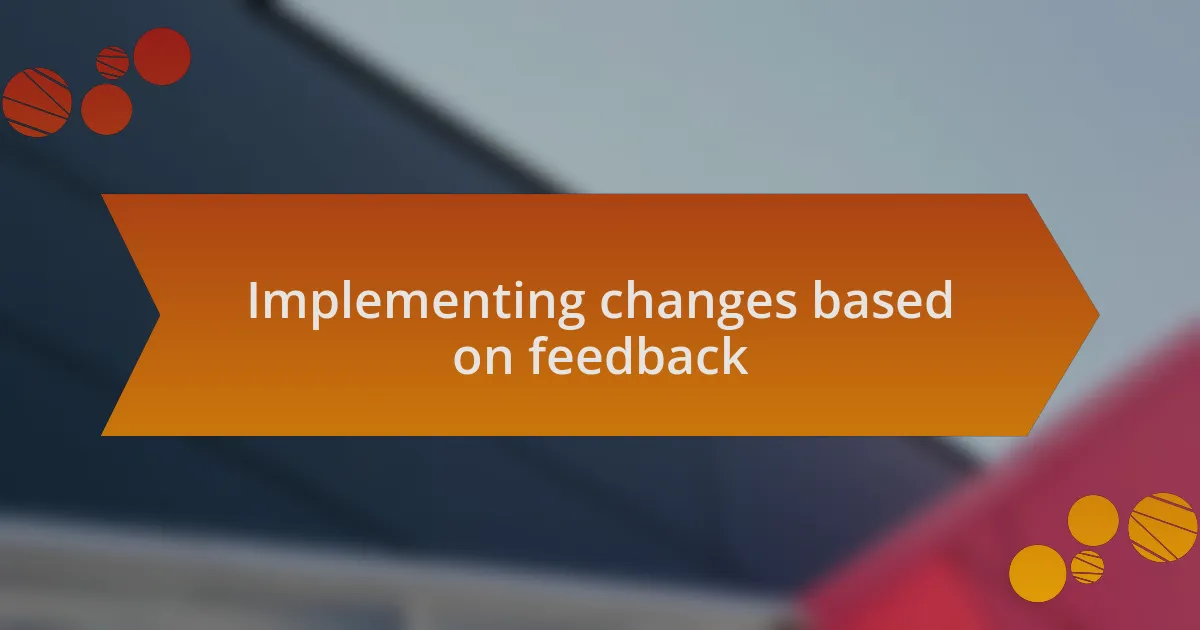
Implementing changes based on feedback
Implementing changes based on feedback is where the real transformation occurs. After one event, I noted that many attendees felt overwhelmed by the sheer number of art pieces on display. Inspired by their comments, I decided to curate a smaller, themed exhibition that allowed each piece to breathe, inviting deeper contemplation. Have you ever felt lost in a gallery? This shift made a world of difference for our visitors, allowing them to connect more meaningfully with the art.
In another instance, the feedback highlighted a desire for clearer information about the artworks. As someone who loves storytelling through art, I was moved to create detailed placards that included not just titles and artists, but also the inspiration behind each piece. Seeing guests stop, read, and engage with the narratives provided them an enriched experience. Isn’t it rewarding when you see your audience truly connect with what they’re experiencing?
I also learned the importance of offering varied formats for interaction. One suggestion that resonated with me was to incorporate artist-led workshops. I can still recall the energy in the room during our first workshop; it was electric. Participants were deeply engaged, creating alongside the artist and forging a stronger bond to the artwork. Isn’t that what we’re ultimately striving for? Connecting people with art in a way that feels personal and genuine?
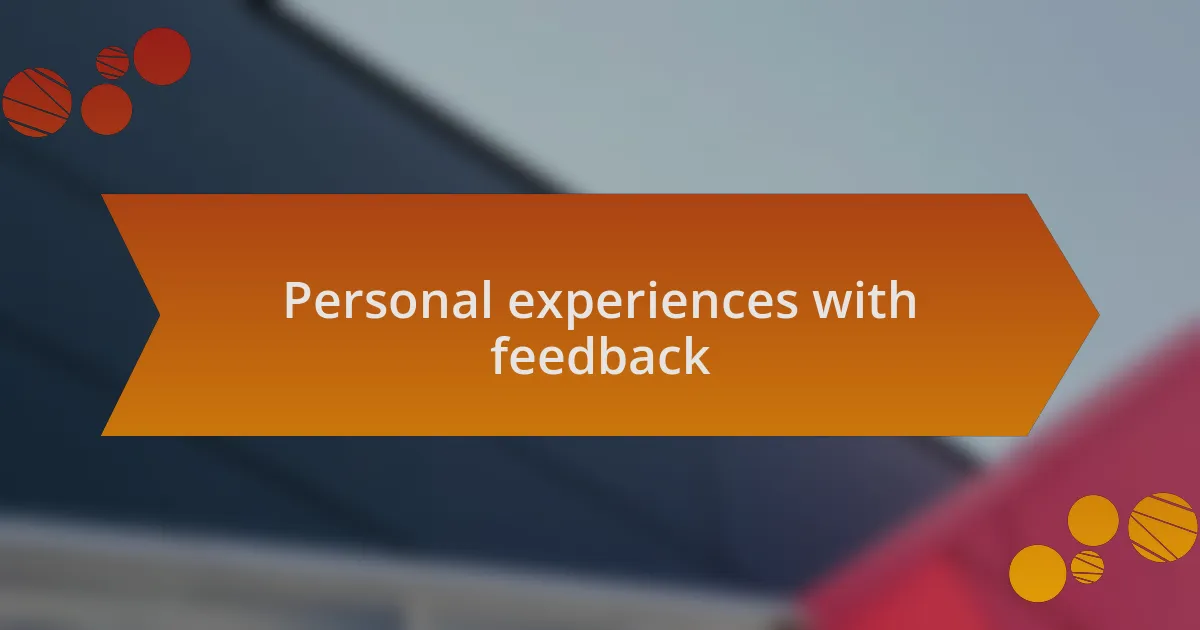
Personal experiences with feedback
I remember a time when I received feedback on the seating arrangement at one of our openings. Several attendees mentioned that they felt uncomfortable while trying to engage in conversations. After reflecting on those comments, I rearranged the seating to create cozy, inviting clusters rather than rigid rows. The next event was a revelation. Conversations flowed easily, and the atmosphere transformed into one of warmth and connection. Have you ever walked into a space and immediately felt at home?
Another instance that stands out was an email I received from a newcomer to the gallery. They shared how overwhelmed they felt during their first visit, struggling to absorb so much beauty all at once. This feedback struck a chord with me; I understood how hard it can be to take everything in. I implemented a friendly guided tour option to help ease that initial overwhelm, allowing visitors to savor the experience rather than rush through it. Isn’t it incredible how minor adjustments can radically change someone’s experience?
During one of our exhibitions, someone suggested we include interactive elements for children. Initially, I was hesitant, thinking it might distract from the art itself. But after considering the feedback, I organized a dedicated corner with art activities, and what a joy it was! Watching families bond over creating their own masterpieces added a delightful layer to the event. It made me realize that art can be an experience for all ages. Have you ever considered how a small change can ripple out to touch so many lives?
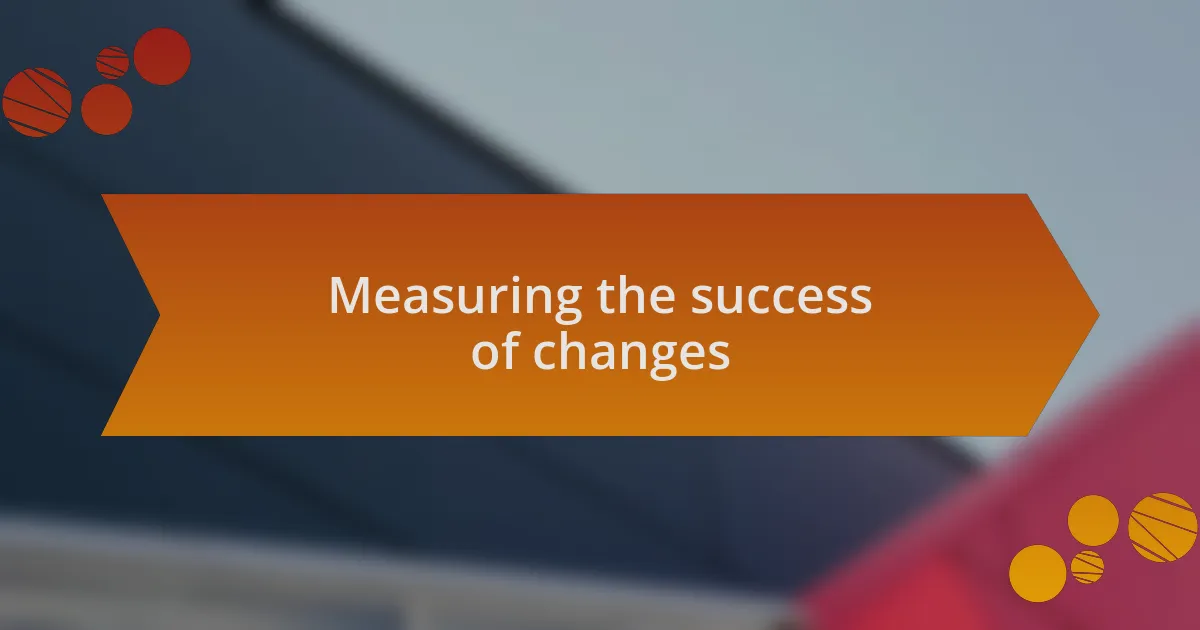
Measuring the success of changes
Measuring the success of changes can often feel like looking into a mirror; you see the reflections of your decisions through the reactions of your audience. After adjusting our exhibition layout based on feedback, I noticed a marked increase in foot traffic and prolonged visitor engagement. It was encouraging to witness how these changes resonated with attendees, prompting me to ask myself: are we truly meeting their needs?
I remember after implementing guided tours, a parent approached me, expressing gratitude for making their child’s gallery experience enjoyable. Hearing that our efforts genuinely facilitated a deeper connection made the work worthwhile. It’s moments like these that help me gauge the effectiveness of my changes, revealing that success is not just about numbers, but also the emotions we evoke in our visitors.
To truly measure impact, I began collecting informal feedback post-event through brief conversations and quick surveys. This direct engagement has proven invaluable; it’s a constant pulse check on what resonates with our audience. The smiles and laughter I observe or the thoughtfulness of a visitor’s response often convey more than any statistic could. Isn’t it fascinating how personal interactions can provide the most profound insights into our success?